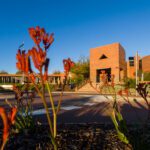Scientists have identified six new or rediscovered Western Australian plant species from photos taken and uploaded to the internet by members of public, including a nature photographer from Jurien Bay, a pair of wildflower enthusiasts from Dongara and a farmer from near the Stirling Range National Park.
Lead researcher, PhD student Thilo Krueger from Curtin’s School of Molecular and Life Sciences said the newly described species were carnivorous sundews and were identified through images shared on Facebook and to the iNaturalist website, highlighting the value of such platforms for contributing to advances in taxonomic research.
“In spite of the extinction crisis we are facing in the 21st Century, undescribed species are regularly discovered and named by scientists each year,” Mr Krueger said.
“However, rates of discovery are limited by the numbers of specialists worldwide, as well as by the frequency with which they can conduct research expeditions, or access preserved specimen collections at museums and herbaria around the world.
“Increasingly, scientists are discovering new species through online data, usually in the form of photos, shared by naturalists, hikers, campers and photographers, who may be experts, amateurs or simply casual observers. These citizen scientists share their findings online and thereby act as the eyes and ears of professional scientists in the field.
“Australia is the world’s richest region for carnivorous plant diversity and also has a thriving community of nature enthusiasts and photographers all eager to capture and share images of plant species on their personal social media pages or that of groups such as The Wildflower Society of Western Australia.”
Jurien Bay nature photographer Daniel Anderson said he felt very proud to have played a part in the naming of the sundew he uncovered in the Lesueur National Park about two years ago.
“It has been more than five years since I started my photography, which at first helped me learn about local plants and animals but since finding the sundew it has become a passion of mine to educate others on the importance of conservation of our unique flora and fauna,” Mr Anderson said.
Mr Krueger said in areas like the Wheatbelt or South West of WA, where more than 97 per cent of all vegetation has been cleared across a vast area, the value of citizen scientists as widely-roaming and unconstrained additional sources of raw biodiversity data could not be overstated.
“This is particularly the case for species that are restricted to small areas, or which emerge for relatively short periods in the growing season before withering away, making them less likely to be encountered,” Mr Krueger said.
“The involvement of members of the public significantly increases the likelihood of chance encounters with such species, allowing scientists to formally document them, to name them if required, and to assess them for their conservation needs.”
The sundews, which produce sticky drops of glue on their tentacled leaves to trap their prey, are at their most diverse in Australia, where approximately 115 of the 260 species known worldwide are endemic to southwest Western Australia alone. Many of these species survive the harsh summer by retreating underground as dormant plants before emerging to trap insects, flower and set seed during their autumn to spring growing season.
Published in Biology, the paper ‘Small leaves, big diversity: citizen science and taxonomic revision triples species number in the carnivorous Drosera microphylla complex’ is available online here.



